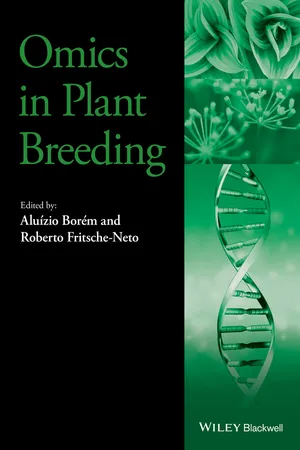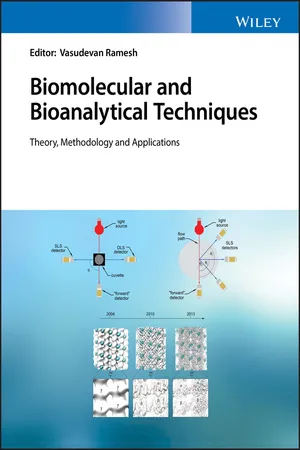Biological Sciences
Bioinformatics
Bioinformatics is a field that combines biology and computer science to analyze and interpret biological data. It involves the use of computational tools and techniques to understand biological processes, such as DNA sequences, protein structures, and gene expression patterns. Bioinformatics plays a crucial role in areas like genomics, evolutionary biology, and drug discovery.
Written by Perlego with AI-assistance
Related key terms
4 Key excerpts on "Bioinformatics"
- eBook - ePub
Theoretical Models and Experimental Approaches in Physical Chemistry
Research Methodology and Practical Methods
- A. K. Haghi, Sabu Thomas, Praveen K.M., Avinash R. Pai(Authors)
- 2018(Publication Date)
- Apple Academic Press(Publisher)
] Bioinformatics is the application of computational tools and techniques to the management and analysis of biological data. Over the past few decades, rapid developments in genomic and other molecular research technologies as well as developments in information technologies have combined to produce a tremendous amount of information related to molecular biology. The primary goal of Bioinformatics is to increase the understanding of biological processes.Bioinformatics develops algorithms and biological software of computer to analyze and record the data related to biology including the data of genes, proteins, drug ingredients, and metabolic pathways. A study has concluded that the creation and analysis of a group of sequences, large data sequences, and adding new modules for visual representation of input data show output results on the Microsoft windows platform. Bioinformatics is the field of science in which biology, computer science, and information technology merge to form a single discipline.[13] Biological data is in need of a certain storage house in which the data can be stored, organized, and manipulated. Thus, biological software and databases provide the scientists and researchers this opportunity, enabling them to extract data from these databases efficiently and effectively.Bioinformatics can be considered to be a combination of several scientific disciplines that include biology, biochemistry, mathematics, and computer science. This is due to the availability of enormous amounts of public and private biological data as well as the compelling need to transform biological data into useful information and knowledge. Additionally, understanding the correlations, structures, and patterns in biological data is the most important task in Bioinformatics. Thus, the knowledge and understanding obtained from these disciplines could be sensibly used for applications that cover drug discovery, genome analysis, and biological control. Furthermore, it involves the use of computer technology and statistical methods to manage and analyze a huge volume of biological data regarding DNA, RNA, protein sequences, protein structure, gene expression profiles, and protein interactions. - Reza K. Haghi, Emili Besalu, Maciej Jaroszewski, Sabu Thomas, Praveen K.M.(Authors)
- 2018(Publication Date)
- Apple Academic Press(Publisher)
If technology has not been made in advance, it may take several years to process a data which is very time-consuming to all the users. 18 Bioinformatics is basically the compilation and management of sciences, data analysis in genomics, proteomics, and in the field of biological sciences. The tools or the software used in the Bioinformatics includes the analysis of quality check, trimming, base calling, assembly, as well as gene prediction 2. These researchers use computer informatics to process lab work or the lab data. They not only work in lab with hands on tube or thermometer doing experiments but also need computers in order to store their findings as well as to compute their end results. It really helps the lab researchers to store their data in order to be used in the future, helps them to understand more of their studies, be able to perform accurately with the correct use of data, and be able to determine the results in a split second. 18 3.1.1.1 Bioinformatics Claverie and Notredame 7 have stated that it is commonly heard that highly trained professionals used computers to carry out their tasks. However, biologists also use the computers as much as they do other manual task. Biologists use computers not only for writing down some memos and sending out e-mails but also to deal with very specific problems. As a whole, these tasks are called Bioinformatics; simply referred as molecular biology’s computational branch. 7 According to Al-Ageel et al., 1 Bioinformatics is an interdisciplinary methodology by making use of all information that has been gathered and data that are displayed in order to analyze biological data. The use of computer appliances helps the biologists to analyze more of their data easily, able to store as much data or findings that they have into the computer, do a wide research regarding their tasks, as well as to retrieve any of the biological information. The study of Bioinformatics basically involves a biologist- eBook - ePub
- Aluízio Borém, Roberto Fritsche-Neto(Authors)
- 2014(Publication Date)
- Wiley-Blackwell(Publisher)
Currently, Bioinformatics is essential for handling any type of biological data, especially the “omics” megadata. Bioinformatics can be defined as an approach which covers all aspects of acquisition, processing, storage, distribution, analysis, and interpretation of biological information. Through the combination of procedures and techniques of mathematics, statistics, and computer science, several tools can be called upon that help us understand the biological meaning contained in “omics” biological data. Furthermore, by creating databases with information already processed, Bioinformatics accelerates the investigation in other biological areas, such as medicine, biotechnology, agronomy, and so on.Hardware for Modern Bioinformatics
The Bioinformatics tools have characteristic features, but a general trend has appeared in recent years: the change from working with software installed on your own computer to the use of a server shared by other research groups. More recently, research is now conducted on large institutional servers. Along with this, the adjustment of researchers to the Linux environment became mandatory. Nowadays it is common for undergraduate students in the biological sciences area to access remote servers. The connection is almost always done by means of a program that runs the connection protocol SSH (Secure Shell) and it is interesting that the triggering of some programs, the monitoring of workflows or even displaying results can be done with applications installed on tablets or even smartphones!In Brazil, the National System of High Performance Computing (SINAPAD) in particular is becoming an increasingly important resource used by research groups in Bioinformatics, and it is quite simple to get an account for project development on the servers of the centers that comprise the SINAPAD, which are known as CENAPAD (National Center of High Performance Computing). Typically, each user runs programs that occupy a significant fraction of the machine, say about 50–100 computational cores, which would not be feasible on a local server, accomplishing its outcome in about a day to a week, depending on the amount of data and analysis. If more cores are available in the machine, parsimoniously it is possible to use them to accelerate the processing of the required routines. - eBook - ePub
Biomolecular and Bioanalytical Techniques
Theory, Methodology and Applications
- Vasudevan Ramesh(Author)
- 2019(Publication Date)
- Wiley(Publisher)
3 Bioinformatics and Its Applications in GenomicsDavid J. Parry‐SmithWellcome Sanger Institute, Hinxton, UK3.1 Significance and Short Background
This chapter introduces the field of Bioinformatics, which is a scientific discipline dealing with the analysis of biological data. More specifically, we deal with Bioinformatics as it is applied to the field of genomics.Biological data can take many forms, including DNA, RNA and protein sequence information. It can encompass higher level collections of data and analyses of data. These include databases of structurally and functionally relevant sequence patterns and databases of small molecule ligand binding sites. It can also encompass imaging of a wide variety of processes, including X‐ray diffraction data and images of the three‐dimensional structures of DNA, RNA and protein complexes. New forms of biological data are being generated all the time as new experimental approaches are developed. Analysis of the data derived using these techniques is underpinned by a sound understanding of how Bioinformatics relates to the functioning of the cellular machinery, whole organisms (e.g. genetics) and even the evolution of species (e.g. phylogenetics).Data analysis has always been fundamental to scientific understanding. Observation leads to classification and generalisation. Rules emerge that enable us to explain the way systems behave now and to predict how they may behave in the future. Such systems range from tracking the course of the planets and stars across the sky to the quantum behaviour of fundamental particles in an atom of helium, say. The development of technology has a major impact on the amount of data available to review and analyse.In the field of Bioinformatics, data gathered on the primary sequence of proteins and the order of the bases comprising the sequences of the DNA of genes have resulted in substantial repositories that are freely available to the public for exploration. The teams of scientists that isolated and cloned the individual genes whose sequences were deposited in these data resources published their work in the scientific literature, at the same time depositing their data in a sequence database. Scientists interested in determining the three‐dimensional structure of the protein that the gene expresses also deposited their data upon publication, but in databases more appropriately designed to hold such data. Bioinformatics is fundamentally involved in providing the means for collating (gathering), analysing and curating (maintaining or looking after) the databases of structural coordinates and DNA or protein sequence. These resources are referred to as primary resources because they contain the actual data determined by the experimental science. Secondary resources
Learn about this page
Index pages curate the most relevant extracts from our library of academic textbooks. They’ve been created using an in-house natural language model (NLM), each adding context and meaning to key research topics.



